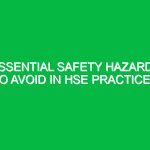Introduction
In the realm of Health, Safety, and Environment (HSE) practices, understanding the language of Safety is paramount. One of the critical components of this Safety lexicon is the term “SDS signal words.” The acronym SDS stands for Safety Data Sheet, a document that provides essential information about hazardous substances. SDS signal words are integral to these documents, acting as immediate indicators of the level of hazard associated with a chemical or substance. They serve not only as warnings but also as guides for safe handling, storage, and disposal practices. In this article, we will delve deep into the significance of SDS signal words, their application in HSE practices, and their role in promoting a culture of safety in various industries.
Understanding SDS Signal Words
SDS signal words are categorized primarily into two types: “Danger” and “Warning.” These words are not just mere labels; they convey crucial information regarding the potential Hazards of chemicals.
- Danger: This signal word indicates a more severe level of hazard. Chemicals categorized under this signal word usually pose a significant risk of serious injury or adverse health Effects. For instance, a cleaning agent that contains corrosive substances may bear the “Danger” label.
- Warning: This signal word signifies a less severe hazard level compared to “Danger.” It alerts users to potential risks that could lead to injury or health issues, albeit generally less severe than those indicated by the “Danger” label. An example would be a household cleaner that can irritate skin or eyes.
Understanding these signal words is crucial for anyone who interacts with hazardous materials. They provide an immediate understanding of the severity of the risks involved, which can dictate the necessary Precautions and protective measures to be taken.
Key Aspects of SDS Signal Words in HSE
SDS signal words are not only labels; they play a pivotal role in ensuring Workplace Safety and compliance with Regulations. Here are some key aspects to consider:
1. Hazard Identification
The primary purpose of SDS signal words is to facilitate hazard identification. By simply glancing at the signal word on an SDS, workers can quickly gauge the level of risk associated with a chemical. This immediate recognition can be lifesaving. For instance, a construction worker handling solvents must understand that a “Danger” label implies a need for more protective gear than a “Warning” label would suggest.
2. Compliance with Regulations
Numerous regulations govern the labeling and documentation of hazardous substances. In the United States, the Occupational Safety and Health Administration (OSHA) has established the Hazard Communication Standard (HCS), which mandates that chemical manufacturers, importers, and employers provide comprehensible information about hazardous chemicals. SDS signal words are a key component of these regulations, ensuring that workers are informed and protected. In Europe, the Classification, Labelling and Packaging (CLP) regulation serves a similar purpose, reinforcing the importance of signal words in ensuring safety.
3. Training and Awareness
Effective Training programs are vital for fostering a safety-first culture in the workplace. Employees should be trained to recognize and interpret SDS signal words. A real-life example can be drawn from a manufacturing plant that implemented regular safety training sessions. During these sessions, employees learned to read and understand SDS signal words, which significantly reduced the number of chemical-related incidents.
4. Risk Management
Incorporating SDS signal words into risk management strategies can enhance safety protocols within an organization. By evaluating the Hazards associated with different chemicals, companies can develop tailored Safety Measures. For example, if a particular cleaning agent is labeled with “Danger,” the organization may require additional Personal Protective Equipment (PPE) for employees using that agent.
5. Emergency Preparedness
SDS signal words also play a crucial role in emergency preparedness. In the event of a spill or exposure, knowing the signal word associated with a substance can guide first responders in their actions. For instance, if a hazardous material labeled “Danger” spills, emergency personnel need to be aware that immediate medical attention may be necessary.
Potential Hazards and Safety Considerations
Understanding SDS signal words also involves recognizing the potential hazards they signify. Different chemicals pose various risks, and being aware of these risks is a fundamental aspect of Workplace Safety.
1. Chemical Exposure
Exposure to hazardous chemicals can lead to acute or chronic health effects. An SDS indicating a “Danger” signal word may relate to a carcinogen or a neurotoxin, which could have severe implications for workers’ health. Therefore, safety measures must be in place to mitigate exposure risks, including proper ventilation, usage of appropriate PPE, and training on safe handling practices.
2. Environmental Impact
Many chemicals that carry “Danger” or “Warning” labels can have detrimental effects not only on human health but also on the environment. For example, improper disposal of substances like solvents can lead to soil and water contamination. Understanding the meaning behind the signal words can drive organizations to implement better waste management practices, contributing to environmental Sustainability.
3. Safe Handling and Storage
Knowing the implications of SDS signal words can guide safe handling and storage practices. For instance, a chemical labeled with “Danger” may require specific storage conditions, such as temperature control or segregation from incompatible substances. This level of awareness can prevent accidents and promote safe operations within facilities.
4. Incident Response
In the event of an accident or exposure, understanding the SDS signal words associated with the chemicals involved can direct the response measures. For instance, if a chemical labeled with “Danger” spills, proper spill containment and reporting protocols must be activated to mitigate risks.
Best Practices for Implementing SDS Signal Words in HSE Practices
To fully harness the Benefits of SDS signal words, organizations must adopt Best Practices that promote their effective use in HSE practices.
1. Regular Training and Refreshers
Conducting regular training sessions ensures that employees remain aware of the significance of SDS signal words. These sessions should cover updates in regulations, changes to safety protocols, and new substances introduced in the workplace.
2. Clear Labeling and Signage
Employers should ensure that all hazardous materials are clearly labeled with their respective SDS signal words. Additionally, placing signage in areas where hazardous substances are used or stored can serve as a constant reminder of the associated risks.
3. Accessible Safety Data Sheets
Safety Data Sheets should be easily accessible to all employees. Organizations can create digital databases or physical folders containing SDS for all hazardous substances used in the facility. This accessibility enables workers to reference safety information when needed.
4. Promote a Safety Culture
Encouraging a culture that prioritizes safety can motivate employees to take the necessary Precautions when handling hazardous materials. Leadership should model safe behaviors and reward employees who actively participate in safety initiatives.
Regulations and Standards Governing SDS Signal Words
The importance of SDS signal words is underscored by various regulations and standards that govern their use.
1. osha Hazard Communication Standard (HCS)
In the United States, OSHA’s Hazard Communication Standard (HCS) requires that all employers communicate the hazards of chemicals to their employees. This includes the use of SDS signal words. By complying with the HCS, employers ensure that workers are informed about the risks associated with hazardous substances, promoting a safer workplace.
2. Globally Harmonized System (GHS)
The Globally Harmonized System (GHS) is an international framework for the classification and labeling of chemicals. It standardizes the use of SDS signal words across different countries, facilitating international trade and communication about chemical hazards. By adhering to GHS guidelines, organizations can ensure that their safety practices align with global standards.
Conclusion
In conclusion, SDS signal words are essential tools in the domain of health, safety, and environmental practices. They serve as critical indicators of the hazards associated with chemicals, guiding workers in safe handling, storage, and emergency response. Understanding and utilizing these signal words can significantly enhance Workplace Safety and compliance with regulatory standards.
By promoting Best Practices, training, and awareness around SDS signal words, organizations can foster a culture of safety that not only protects employees but also contributes to environmental sustainability. As workplaces continue to evolve, the importance of clear communication regarding chemical hazards remains a cornerstone of effective HSE practices. The call to action is clear: prioritize the understanding and implementation of SDS signal words to unlock safety in every facet of your operations.


